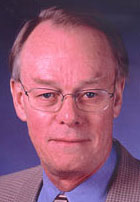- Number 291 |
- July 20, 2009
A bright future for biological crystallography

Wayne Hendrickson
Biophysicist Wayne Hendrickson, a Howard Hughes Medical Institute investigator at Columbia University, considers what we’ve learned about HIV, the virus that causes AIDS, a huge biological success story. In the relatively short time since its discovery in the early 1980s, he and other scientists have revealed myriad details about the virus’ structure and mechanism of action, and are actively developing and testing drugs to block its entry into cells.
Some of this groundbreaking research has taken place at beamlines built by Hendrickson at the National Synchrotron Light Source (NSLS) at DOE's Brookhaven Lab, where he has continually refined methods for analyzing proteins and other biological structures using x-ray crystallography. These studies have revealed details of not just the AIDS virus, but membrane receptors and cellular signaling mechanisms, other viral proteins, molecular chaperones, and protein folding as well.
If past success is any indication, the future of crystallography will be even brighter. As Hendrickson said recently at a special science briefing at Brookhaven, what was challenging in the early days of crystallography has now become routine, and what is challenging today will be routine in 2015—the year a new synchrotron light source is due to open at BNL.
Hendrickson will be instrumental in the success of that facility, known as NSLS-II, which is now under construction at the Lab. He was recently named Associate Project Director for Life Sciences at NSLS-II, where he will develop the strategic plans for life sciences research; communicate with funding agencies; represent the needs of life scientists in the design and construction of NSLS-II; and oversee the development, construction, and operation of life sciences facilities, including beamlines.
With the optimism and dedication he’s known for, he’ll do it all while maintaining his “day” job at Columbia—and his own important research into the inner workings of biological structures.
Submitted by DOE's Brookhaven National Laboratory
